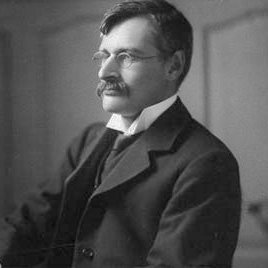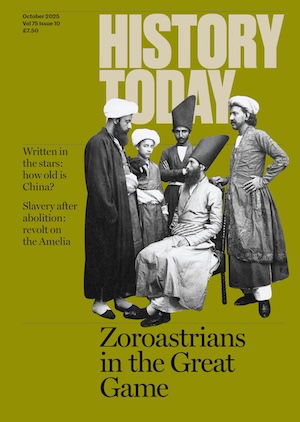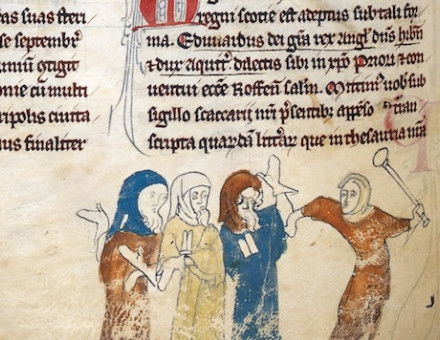George Macaulay Trevelyan, 1876-1962
George Macaulay Trevelyan, one of the last Whig historians, died on 21st July 1962.

During the immediate aftermath of the First World War, G.M. Trevelyan was an impressive, though characteristically modest and unassuming, figure in the small Hertfordshire community where he had at that time made his home. Other historians then inhabited Berkhamsted or its immediate neighbourhood - Barbara and J.L. Hammond, who, for the sake of healthful exercise rather than from a love of sport or speed, used to ride very slow and shaggy mounts over the surrounding hills; R. H. Tawney, economic expert and Socialist pioneer, and Esmé Wingfield Stratford, author of The History of English Patriotism and eloquent champion of King Charles I. But Trevelyan seemed the Liberal Historian par excellence - a tall, slightly stooping figure, with steel- or silver-rimmed spectacles beneath heavy overhanging eyebrows, silvered hair and a descending silvery moustashe. He would have looked recognizably English wherever he appeared; and, once he had begun to talk, it would not have been difficult to assign him to his proper place in the contemporary social system, as a distinguished member of one of those eminent families who have done so much for English literature and scholarship - the Trevelyans, the Macaulays, the Arnolds, the Stracheys, the Stephens and the Wedgwoods. He himself was the grand-nephew of Thomas Babington Macaulay; and his wife, the daughter of Mrs. Humphrey Ward, was the niece of Matthew Arnold. These interrelated families formed an aristocracy of their own; and although they were greatly addicted to the middle-class virtues of high thinking and austere living, they had most of them a fairly substantial stake in the background of their native country. The Trevelyans, for instance held two landed estates, in Northumberland and near Stratford-on-Avon. G.M. Trevelyan had may of the countrymen's interests; and, in his last contribution to the pages of Who's Who, he listed under "Recreations" both shooting and cross country walking.
On some of his Hertfordshire walks, one of the editors of this magazine was occasionally privileged to accompany him; and he well remembers how Trevelyan covered the miles, in his baggy tweed knickerbockers, his grey ribbed woollen stockings and his large serviceable black boots, maintaining an extremely strenuous pace but keeping up at the same time an energetic conversational flow. He could be brusque; he was occasionally impatient, but never pompous or unsympathetic. His processes of thought were neither frivolous nor facile; but did not lack a shrewd humour. Now and then, he talked of the past and mentioned the famous great-uncle whose literary and historical influence had helped to shape his early writings. He told, for example, a story about Macaulay that concerned the effect he had made upon his nephew. When Sir George Otto Trevelyan lay dying, he indicated that he had an important message to communicate - possibly a somewhat painful message. George Trevelyan bent towards his father and caught the whispered last words. "Uncle Tom" was the subject. "Uncle Tom," murmured Sir George regretfully, "wasn't quite a gentleman!..."
To G.M. Trevelyan this magazine owes a profound debt. During the years after the Second World War, he was tireless in his efforts to find a promoter for an illustrated magazine of popular, yet scholarly, history, and he played a large part in securing the interest of our first chairman, the late Lord Bracken. Trevelyan's own achievements in the field of popular scholarship were various and fertile. Whether he was writing detailed narrative volumes upon the Age of Queen Anne or, earlier, the making of modern Italy, whether he was composing biographies of nineteenth-century British statesmen, displaying his comprehensive judgment in his general History of England, or crowning his career with his marvelous English Social History, all his work was inspired by a deep desire to understand the springs of action and to describe with sympathy the course of human behaviour over the centuries. By nature and upbringing, he was of the Whig tradition, and later analysts have questioned some of his more enthusiastic appreciations and assumptions. But upon his integrity, compassion and high principles, no one could cast doubt. Nor upon his moral concern that the many-sided lessons of history should be widely understood. To the first issue of this paper, Trevelyan generously contributed a message in which, we feel, he summed up his own belief and lucid practice:
There is no more hopeful and no more important part of our present day culture and education than this presentation of the results of historical scholarship to people at large.




